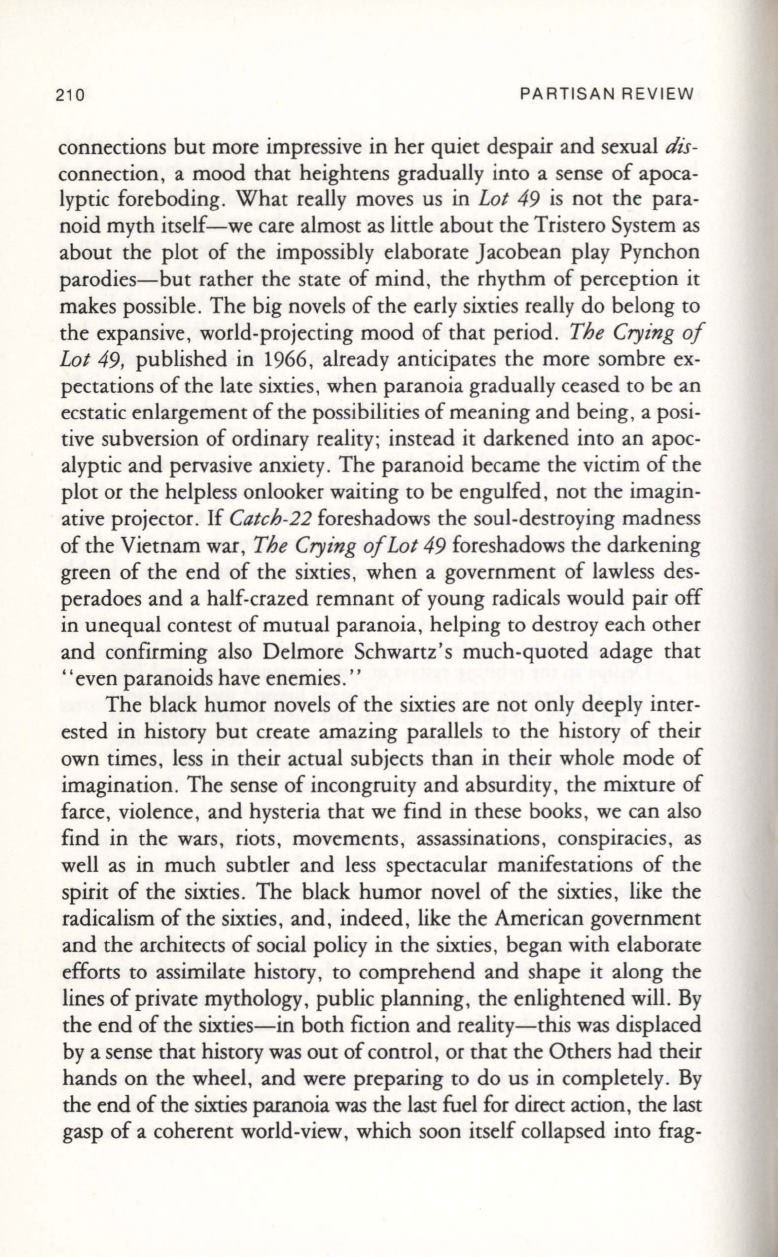
210
PARTISAN REVIEW
connections but more impressive in her quiet despair and sexual
dis–
connection, a mood that heightens gradually into a sense of apoca–
lyptic foreboding . What really moves us in
Lot
49 is not the para–
noid myth itself-we care almost as little about the Tristero System as
about the plot of the impossibly elaborate Jacobean play Pynchon
parodies-but rather the state of mind , the rhythm of perception it
makes possible. The big novels of the early sixties really do belong to
the expansive, world-projecting mood of that period.
The
Crying
of
Lot
49, published in 1966 , already anticipates the more sombre ex–
pectations of the late sixties , when paranoia gradually ceased to be an
ecstatic enlargement of the possibilities of meaning and being, a posi–
tive subversion of ordinary reality; instead it darkened into an apoc–
alyptic and pervasive anxiety. The paranoid became the victim of the
plot or the helpless onlooker waiting to be engulfed , not the imagin–
ative projector. If
Catch-22
foreshadows the soul-destroying madness
of the Vietnam war,
The
Crying
ofLot
49 foreshadows the darkening
green of the end of the sixties , when a government of lawless des–
peradoes and a half-crazed remnant of young radicals would pair off
in unequal contest of mutual paranoia, helping to destroy each other
and confirming also Delmore Schwartz's much-quoted adage that
"even paranoids have enemies. "
The black humor novels of the sixties are not only deeply inter–
ested in history but create amazing parallels to the history of their
own times, less in their actual subjects than in their whole mode of
imagination. The sense of incongruity and absurdity, the mixture of
farce, violence, and hysteria that we find in these books, we can also
find in the wars , riots, movements , assassinations, conspiracies, as
well as in much subtler and less spectacular manifestations of the
spirit of the sixties . The black humor novel of the sixties , like the
radicalism of the sixties, and, indeed, like the American government
and the architects of social policy in the sixties, began with elaborate
efforts
to
assimilate history,
to
comprehend and shape it along the
lines of private mythology, public planning, the enlightened will. By
the end of the sixties-in both fiction and reality-this was displaced
by a sense that history was out of control, or that the Others had their
hands on the wheel, and were preparing to do us in completely. By
the end of the sixties paranoia was the last fuel for direct action, the last
gasp of a coherent world-view, which soon itself collapsed into frag-


